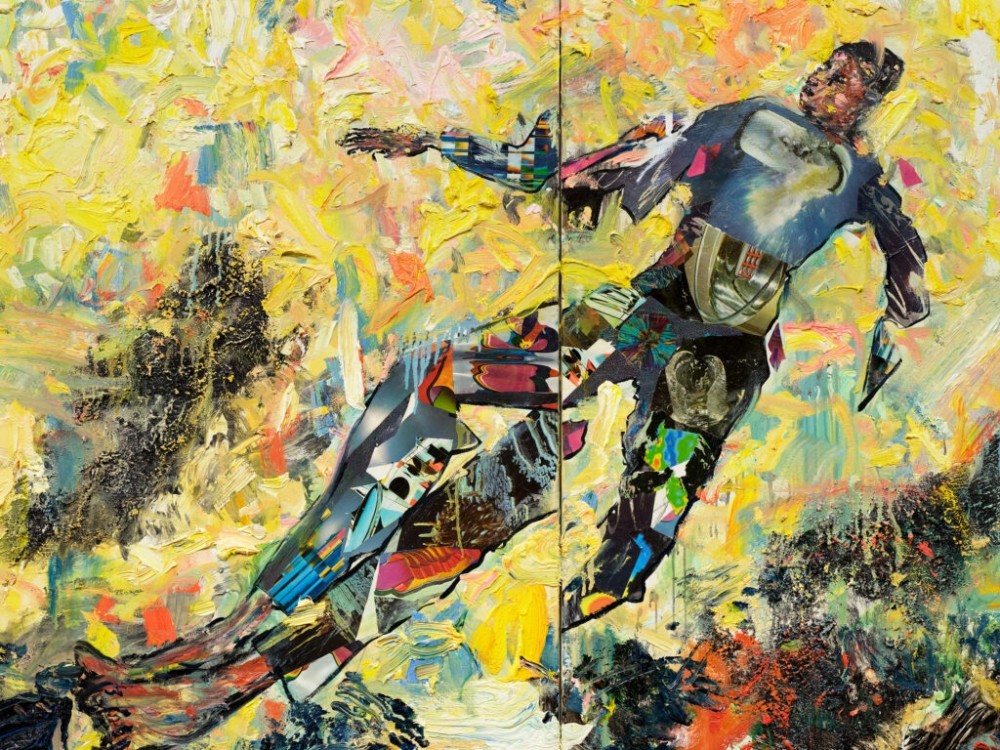
Mario Joyce: Spirt, Spirt
Vielmetter Los Angeles is excited to announce Spirit, Spirit, Los Angeles-based painter Mario Joyce’s first exhibition at the gallery, on view from November 23, 2024, through January 18, 2025.
Joyce’s work delves into how memories evolve over time and across generations, transforming into intricate capsules of meaning that convey messages of identity, belonging, and place. Originally from South Solon, Ohio, Joyce draws heavily from his family’s history. Through years of tracing his genealogy, he has uncovered numerous stories from his relatives, revealing untold truths and embellished narratives that weave a rich tapestry of his familial origins. These reflections are processed through his layered paintings, allowing Joyce to channel ancestral messages and generational traumas that have shaped his identity as a Queer Black man in rural America.
Joyce’s work raises the question: what purpose do these stories, whether true or partially true, serve in shaping our individual and collective identities? He particularly highlights the significance of these narratives for African American families, who have relied on oral histories as a means of survival amid centuries of oppression. The answer is found within his intricate compositions, which incorporate various mediums—soil, oil paint, and photographs—layered together to create depth and resonance. In He Hears Echoes, a triptych, Joyce imagines how these family tales transform into lived experiences. A figure, reminiscent of a self-portrait, floats across the canvases, grounded by a blackened earth and a bright yellow sky. His body is composed of collaged materials featuring psychedelic imagery from the 1960s and ’70s, reflecting the inner turmoil and confusion of that era, both socially and politically, which still resonates today. For Joyce, the work involves processing these intangible experiences and their impact on our bodies, subconsciousness, and present lives.
Each painting begins with soil collected from his family’s farm in rural Ohio. Growing up, Joyce listened to many stories about his ancestors who cultivated this land, seeing the soil as an extension of his family’s history. It symbolizes his heritage, allowing him to channel his ancestors’ presence through this earthy material. Layers of paint overlay the soil, embedding it into his compositions and creating a visual metaphor for both burying and unearthing his genealogy. In I Saw a Spirit, Where Have You Gone?, the figure and landscape blend into one another, creating an in-between space that bridges the real and the spiritual. Dark trees frame the work like pillars, while drips flow into the forest floor like roots, signifying a state of becoming and representing a transitional space of transformation.
Joyce’s practice centers on his genealogical research. Stories like that of his ancestor Charles Revels—who helped establish a free Black community in Ohio as part of the Underground Railroad—serve as deep sources of inspiration. In As From Above, a photo of Civil War U.S. Colored Troops is juxtaposed with an image of Joyce’s fifth great-grandfather, Alexander Reynolds, framed by two hands. Reynolds joined the troops and, though he did not survive the war, he ensured liberation for his wife and daughters, who used his pension to purchase land. Tragically, after his wife’s death, the land was lost in lawsuits against her probate that could not be disproved. Today, Joyce’s family still resides near the Reynolds Plantation in Patrick County, Virginia, owned by the same family that produces Reynolds aluminum foil and Camel cigarettes. This long view of history is central to Joyce’s project, illustrating how various tellings of the same story from different family members converge to form a constellation of truth about one’s origins.
By engaging with these personal histories, Joyce not only preserves but also continues the act of storytelling. He foregrounds stories as essential to the formation of culture and cultural identity—his genealogical research and family tree not only serve personal reflection but also reveal broader truths about our collective histories that often remain concealed. His works act as conduits for communicating with his ancestors and visualizing the complex web of his family’s legacy, particularly as it relates to his self-identity. In his words, “The process of making the work is one of pausing in deep observation of the ancestral messages I have inherited. The act of burying, exposing, and repeating this process on the canvas allows for necessary reflection on what it means to inhabit my own skin. The archaeological act of digging up the past, processing what is found, researching what we are capable of knowing, and waiting for the truth to reveal itself in its own time is how I approach each canvas.”
Mario Joyce (b. 1985) lives and works in Los Angeles. Joyce is self-taught and has participated in several residencies including, Sointula House Residency, Sointula, BC (2024); Skowhegan School of Painting and Sculpture, Skowhegan, ME (2023); Pratt Forward, Pratt Institute, Brooklyn, NY (2022); La Brea Studio Residency, Los Angeles, CA (2021). His work has been the subject of solo exhibitions at UTA Artist Space, Los Angeles, CA (2024); Sakhile&Me, Frankfurt, Germany (2023); UTA Art Space, Atlanta, CA (2022). He has been included in numerous group exhibitions at MUZEO Museum and Cultural Center, Anaheim, CA (2024); F2T Gallery, Milan, Italy (2023); New York Culture Club, New York, NY (2022); Over the Influence, Los Angeles, CA (2022), among others.